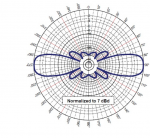WRFM426
Member
New to this group, and fairly new to GMRS...
I live in a slightly hilly/wooded area of Massachusetts, and am looking to set up a GMRS Base Station to communicate with friends and family in the surrounding area. With an HT I get ~3miles from my house (ground floor) to a number of locations, so am thinking that a base station with a suitable antenna say 10ft above my roof should extend that reach.
Currently and specifically, I am looking a few antennas, such as:
- Laird FG4603 / 4605
- CommScope DB-404B
- DPD GMRS Vertical Outdoor Base Antenna
As a more general question too: what are the relative merits of a dipole vs a linear antenna?
Depending on how this part of the 'project' goes, I may consider later setting up a Repeater..
Your thoughts and assistance would be much appreciated..
I live in a slightly hilly/wooded area of Massachusetts, and am looking to set up a GMRS Base Station to communicate with friends and family in the surrounding area. With an HT I get ~3miles from my house (ground floor) to a number of locations, so am thinking that a base station with a suitable antenna say 10ft above my roof should extend that reach.
Currently and specifically, I am looking a few antennas, such as:
- Laird FG4603 / 4605
- CommScope DB-404B
- DPD GMRS Vertical Outdoor Base Antenna
As a more general question too: what are the relative merits of a dipole vs a linear antenna?
Depending on how this part of the 'project' goes, I may consider later setting up a Repeater..
Your thoughts and assistance would be much appreciated..


